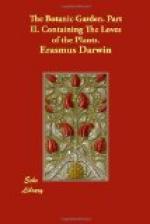The light was most brilliant on Marigolds, of an orange or flame colour; but scarcely visible on pale ones.
The flash was frequently seen on the same flower two or three times in quick succession, but more commonly at intervals of several minutes; and when several flowers in the same place emitted their light together, it could be observed at a considerable distance.
This phaenomenon was remarked in the months of July and August, at sun-set, and for half an hour after, when the atmosphere was clear; but after a rainy day, or when the air was loaded with vapours, nothing of it was seen.
The
following flowers emitted flashes, more or less vivid,
in this
order:
1. The Marigold, (Calendula Officinalis). 2. Garden Nasturtion, (Tropaeolum majus). 3. Orange Lily, (Lilium bulbiferum). 4. The Indian Pink, (Tagetes patula et erecta).
Sometimes it was also observed on the Sun-flowers, (Helianthus annuus). But bright yellow, or flame colour, seemed in general necessary for the production of this light; for it was never seen on the flowers of any other colour.
To discover whether some little insects, or phosphoric worms, might not be the cause of it, the flowers were carefully examined even with a microscope, without any such being found.
From the rapidity of the flash, and other circumstances, it might be conjectured, that there is something of electricity in this phaenomenon. It is well known, that when the pistil of a flower is impregnated, the pollen bursts away by its elasticity, with which electricity may be combined. But M. Haggren, after having observed the slash from the Orange-lily, the anthers of which are a considerable space distant from the petals, found that the light proceeded from the petals only; whence he concludes, that this electric light is caused by the pollen, which in flying off is scattered upon the petals. Obser. Physique par M. Rozier, Vol. XXXIII. p. iii.
P. 153. Addition to Avena. The following lines were by mistake omitted; they were designed to have been inserted after l. 102, p. 153.
Green
swells the beech, the widening knots improve,
So
spread the tender growths of culture’d love;
Wave
follows wave, the letter’d lines decay,
So
Love’s soft forms neglected melt away.
P. 157. Additional note to Bellis. Du Halde gives an account of a white wax made by small insects round the branches of a tree in China in great quantity, which is there collected for economical and medical purposes: the tree is called Tong-tsin. Description of China, Vol. I. p. 230.
Description of the Poison-Tree in the Island of JAVA. Translated from the original Dutch of N. P. Foerich.
This destructive tree is called in the Malayan language Bohon-Upas, and has been described by naturalists; but their accounts have been so tinctured with the marvellous, that the whole narration has been supposed to be an ingenious fiction by the generality of readers. Nor is this in the least degree surprising, when the circumstances which we shall faithfully relate in this description are considered.




